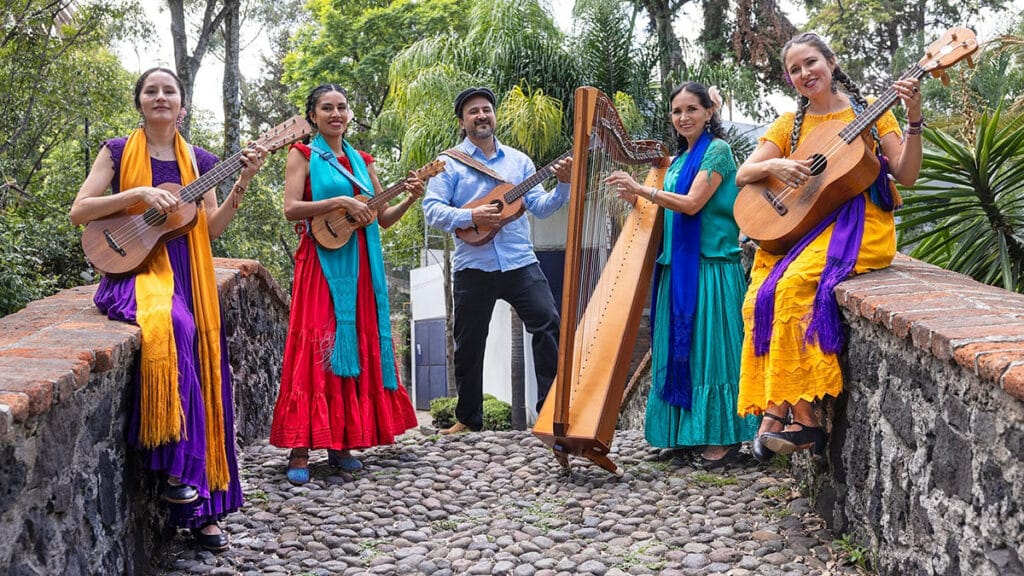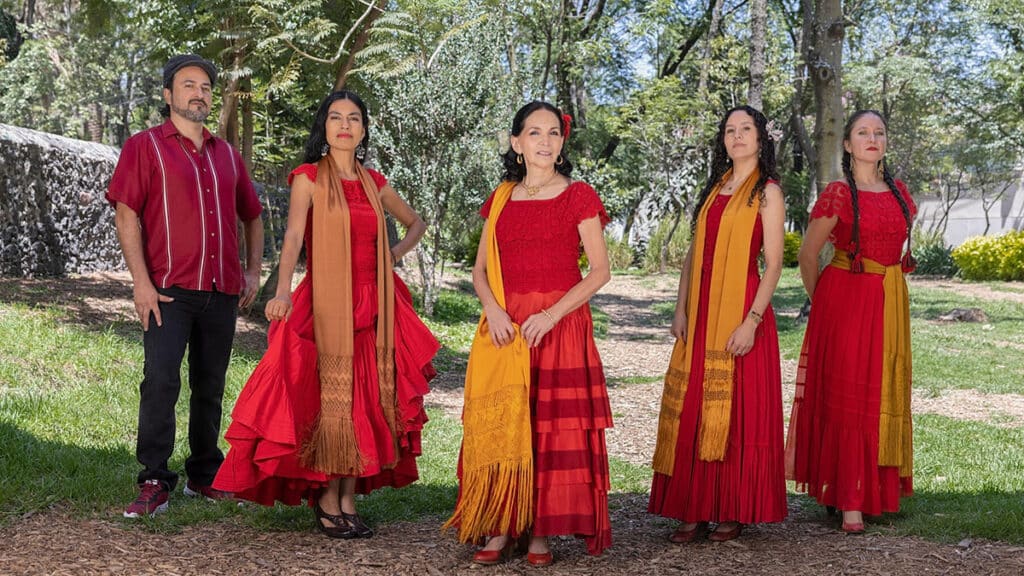Caña Dulce y Caña Brava is a women’s son jarocho group that plays traditional regional Mexican son jarocho with some contemporary lyrical poetry. Performing in traditional costumes and dancing the zapateado (traditional Mexican dance), they are part of this point in time when female artists are dominating the music and dance worlds.
This is a great band that demonstrates both traditions and what women can achieve today. It’s important work because social media is overwhelming traditional culture.
Caña Dulce y Caña Brava in New York City

Carnegie Hall Citywide at El Museo del Barrio
Caña Dulce y Caña Brava plays son jarocho and dances zapateado from Veracruz, Mexico; for Carnegie Hall Citywide at El Museo del Barrio in “El Barrio” East Harlem; on Saturday, May 18, 2024 at 4pm. FREE. carnegiehall.org 🇲🇽
New York Venues
In New York, they have performed for:
They also do a lot of educational outreach.
Caña Dulce y Caña Brava
The band formed in 2007 and has been touring the world lately. The group was founded by Adriana Cao Romero (harp) and Raquel Palacios Vega (jarana).
They were joined later by Violeta Romero Granados (jarana, vocals, zapateado) and Anna Arismendez Gómez (guitarra grande/bass and vocals). Poet and decimista (10-line Hispanic poetry) Evelin Acosta López joins occasionally as a special guest. The decima is a form of ten verses with eight counts that is a root of a lot of Hispanic folk music in the Americas including Puerto Rican música jíbara. As an improviser Evelin becomes basically a decima rapper.
Albums
“Raíz y Canto” (2014) was traditional son jarocho music with contemporary poetry.
“Acentos” (2019) was the band’s coming of age as they found their own voice.
Apparently there is a new album in the works.
“Sweet Sugar Cane, Angry Sugar Cane”

“Sweet Sugar Cane, Angry Sugar Cane” is an interesting name that works on many levels. It captures the contrast between the sweetness of sugar and the brutally violent industry that produces it. It captures the perilous position of women in the Latin world who are both adored and mistreated by Latin machista (male chauvinist) culture. Mistreatment quickly turns a sweet woman into an angry woman.
The name also captures the rebellion that is an inherent part of almost all Latin music, and African heritage. Son jarocho is the oldest of the Mexican sons (sounds). It’s from Veracruz, Mexico’s Caribbean gateway city and colonial slave port. Colonizers trafficked Africans to grow and cut sugar cane. We may not look African any more and have our own Latin identities, but most Mexicans have a “Black grandmother in the closet.” In fact, Kongo musicians from Central Africa were singing “La Bamba,” the famous Mexican wedding song, in Veracruz as early as 1683. Even the way the jarana, the small Veracruz guitar is played, shows African influence. It’s mostly played rhythmically, not melodically like the Spanish guitar.
Everywhere people were enslaved, there were many and constant uprisings against the horrific abuse committed by the slavers. Yanga, also in Veracruz state, became the first free African town in North America in 1631 ~ because Spanish colonial power could not defeat the Free Africans and Indigenous Mexicans led by Gaspar Yanga.
The colonizers knew we could quickly communicate long distances through rhythm, and feared uprisings, so they banned drumming. They tried to ban zapateado, the Mexican step dance, but the people said we’re not drumming, we’re just stomping our feet. There are many types of foot dancing around the world, but Mexican foot dancing probably also derives from local Indigenous traditions. Stomping feet is an expression of strong emotions, either joy or anger. So another meaning for the band’s name is the contrast between the angelic sweetness of the harp and jarana ~ and the angry rebellion of zapateado.
Women are the guardians of culture, so when women start stomping their feet, you better pay attention.
More Information
dulceybrava.com
X (Twitter) @dulceybrava
Facebook @CanaDulceyCanaBrava
Instagram @dulceybrava
YouTube @canadulceycanabrava1029
